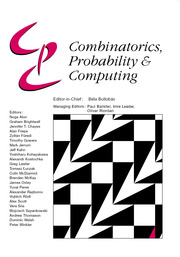Crossref Citations
This article has been cited by the following publications. This list is generated based on data provided by
Crossref.
Sudakov, Benny
2007.
Note making a K 4-free graph bipartite.
Combinatorica,
Vol. 27,
Issue. 4,
p.
509.
Alon, Noga
Bollobás, Béla
Gyárfás, András
Lehel, Jenő
and
Scott, Alex
2007.
Maximum directed cuts in acyclic digraphs.
Journal of Graph Theory,
Vol. 55,
Issue. 1,
p.
1.
Grigoriev, Alexander
Marchal, Bert
and
Usotskaya, Natalya
2010.
SOFSEM 2010: Theory and Practice of Computer Science.
Vol. 5901,
Issue. ,
p.
452.
ALON, NOGA
and
PRAŁAT, PAWEŁ
2011.
Modular Orientations of Random and Quasi-Random Regular Graphs.
Combinatorics, Probability and Computing,
Vol. 20,
Issue. 3,
p.
321.
Lee, Choongbum
Loh, Po-Shen
and
Sudakov, Benny
2016.
Judicious partitions of directed graphs.
Random Structures & Algorithms,
Vol. 48,
Issue. 1,
p.
147.
ZENG, QINGHOU
and
HOU, JIANFENG
2017.
BIPARTITE SUBGRAPHS OF -FREE GRAPHS.
Bulletin of the Australian Mathematical Society,
Vol. 96,
Issue. 1,
p.
1.
Conlon, David
Fox, Jacob
Kwan, Matthew
and
Sudakov, Benny
2019.
Hypergraph cuts above the average.
Israel Journal of Mathematics,
Vol. 233,
Issue. 1,
p.
67.
LIN, JING
ZENG, QINGHOU
and
CHEN, FUYUAN
2019.
MAXIMUM CUTS IN GRAPHS WITHOUT WHEELS.
Bulletin of the Australian Mathematical Society,
Vol. 100,
Issue. 1,
p.
13.
Alon, Noga
2019.
Building Bridges II.
Vol. 28,
Issue. ,
p.
1.
Kwan, Matthew
Letzter, Shoham
Sudakov, Benny
and
Tran, Tuan
2020.
Dense Induced Bipartite Subgraphs in Triangle-Free Graphs.
Combinatorica,
Vol. 40,
Issue. 2,
p.
283.
Carlson, Charles
Kolla, Alexandra
Li, Ray
Mani, Nitya
Sudakov, Benny
and
Trevisan, Luca
2020.
LATIN 2020: Theoretical Informatics.
Vol. 12118,
Issue. ,
p.
479.
Hou, Jianfeng
and
Yan, Juan
2020.
Max-Bisections of H-free graphs.
Discrete Mathematics,
Vol. 343,
Issue. 1,
p.
111590.
Ma, Huawen
2020.
Maximum Cuts in $$\mathscr {H}$$-Free Graphs.
Graphs and Combinatorics,
Vol. 36,
Issue. 5,
p.
1503.
Carlson, Charles
Kolla, Alexandra
Li, Ray
Mani, Nitya
Sudakov, Benny
and
Trevisan, Luca
2021.
Lower Bounds for Max-Cut in $H$-Free Graphs via Semidefinite Programming.
SIAM Journal on Discrete Mathematics,
Vol. 35,
Issue. 3,
p.
1557.
Lin, Jing
and
Zeng, Qinghou
2021.
Maximum bisections of graphs without short even cycles.
Journal of Combinatorial Theory, Series A,
Vol. 180,
Issue. ,
p.
105404.
Ma, Huawen
and
Gobithaasan, R. U.
2022.
Maximum Colored Cuts in Edge‐Colored Complete Graphs.
Journal of Mathematics,
Vol. 2022,
Issue. 1,
Lin, Jing
and
Zeng, Qinghou
2022.
Maximum bipartite subgraphs in graphs without short cycles.
Discrete Applied Mathematics,
Vol. 311,
Issue. ,
p.
18.
Rao, Mengjiao
Hou, Jianfeng
and
Zeng, Qinghou
2022.
Maximum bisections of graphs without cycles of length 4.
Discrete Mathematics,
Vol. 345,
Issue. 8,
p.
112914.
WU, SHUFEI
and
LI, AMIN
2023.
MAX-CUT BY EXCLUDING BIPARTITE SUBGRAPHS.
Bulletin of the Australian Mathematical Society,
Vol. 108,
Issue. 2,
p.
177.
Wu, Shufei
and
Hou, Jianfeng
2023.
Graph partitioning: an updated survey.
AKCE International Journal of Graphs and Combinatorics,
Vol. 20,
Issue. 1,
p.
9.

